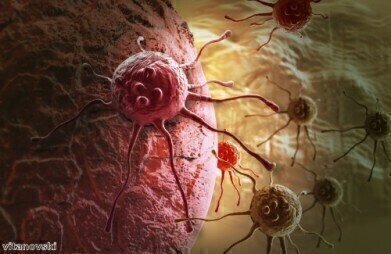-
 The nanoparticles trigger cell death in cancer cells by targeting two areas
The nanoparticles trigger cell death in cancer cells by targeting two areas
Bioanalytical
New nanoparticle delivers two drugs to cancer cells
Jan 06 2014
A new technique has been developed that enables nanoparticles to carry cancer drugs into the body to treat cancer cells. Researchers have created nanoparticles that are able to deliver two different drugs to the body, which then separate to take the drugs to different areas of the cancer cell in order to provide highly effective treatment.
Researchers from the University of North Carolina at Chapel Hill and North Carolina State University, US, have developed the technique that can create the nanoparticles. When tested upon mice in a laboratory, the researchers found that the nanoparticle treatment significantly reduced breast cancer tumours when compared to traditional treatment, according to Dr Zhen Gu, assistant professor in the joint biomedical engineering program at the universities.
“Cancer cells can develop resistance to chemotherapy drugs, but are less likely to develop resistance when multiple drugs are delivered simultaneously. However, different drugs target different parts of the cancer cell. For example, the protein drug TRAIL is most effective against the cell membrane, while doxorubicin (Dox) is most effective when delivered to the nucleus," said Dr Gu.
The new nanoparticles are site specific in their delivery of the drugs, allowing for TRAIL to first be delivered to the membranes of the cancer cells. This then allows them to penetrate the membrane and to deliver Dox to the nucleus of the cell for a more effective form of treatment.
Researchers created the nanoparticles to have an outer shell that are formed of TRAIL woven together with hyaluronic acid (HA). The HA makes the cancer cell "grab" onto the nanoparticle by reacting with the cell's receptors. Enzymes then break the HA down, allowing for the release of TRAIL into the membrane, which then triggers the death of the cell.
This breakdown of HA also uncovers the centre of the nanoparticle, which allows the Dox to reach the nucleus of the cancer cell. The centre of the nanoparticle also contains peptides will make the endosome, which encases the cancer cell's nucleus, to breakdown, allowing for the delivery of Dox, triggering cell death.
Digital Edition
Chromatography Today - Buyers' Guide 2022
October 2023
In This Edition Modern & Practical Applications - Accelerating ADC Development with Mass Spectrometry - Implementing High-Resolution Ion Mobility into Peptide Mapping Workflows Chromatogr...
View all digital editions
Events
May 05 2024 Seville, Spain
May 15 2024 Birmingham, UK
May 19 2024 Brno, Czech Republic
May 21 2024 Lagos, Nigeria
May 23 2024 Beijing, China













